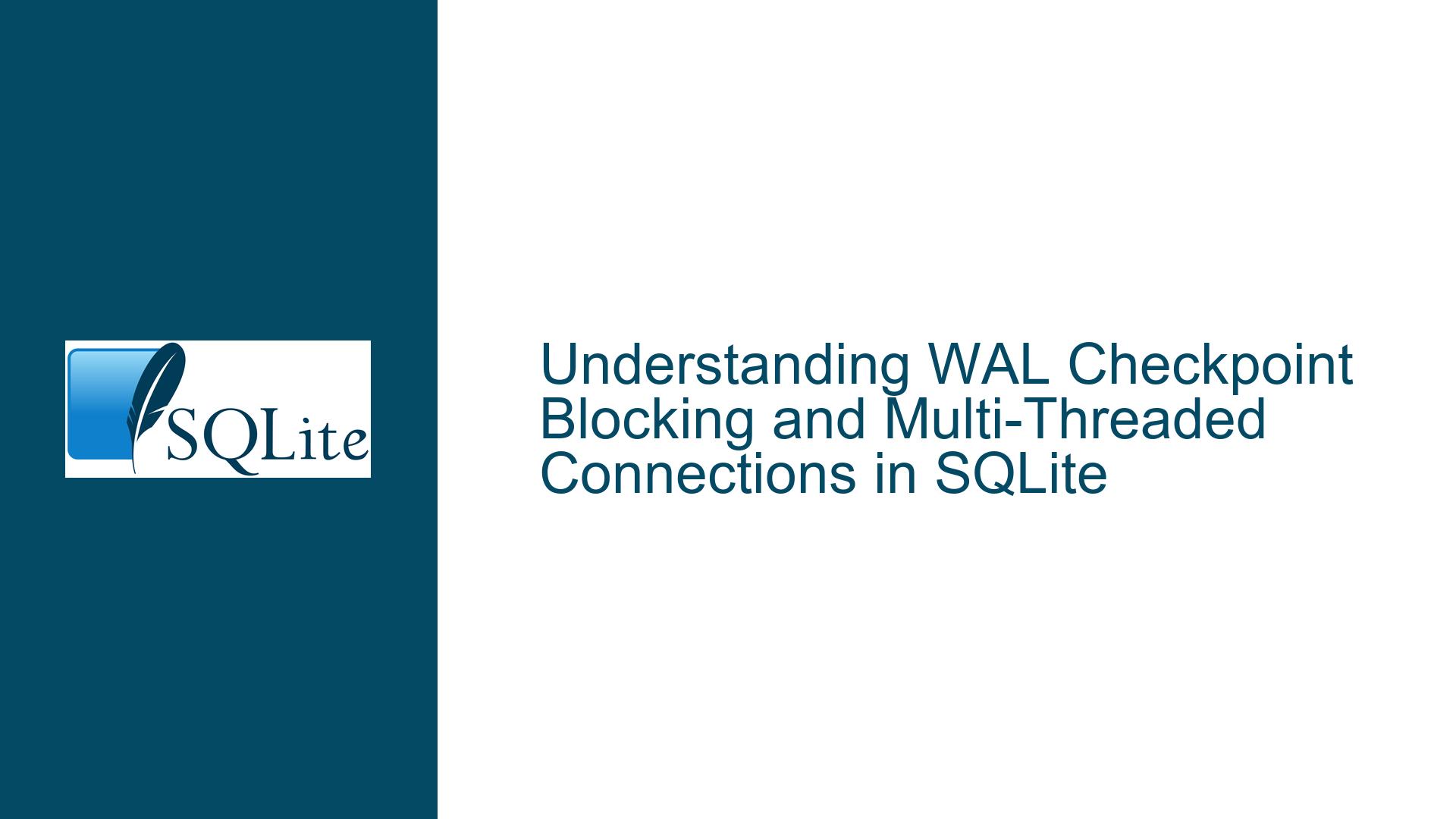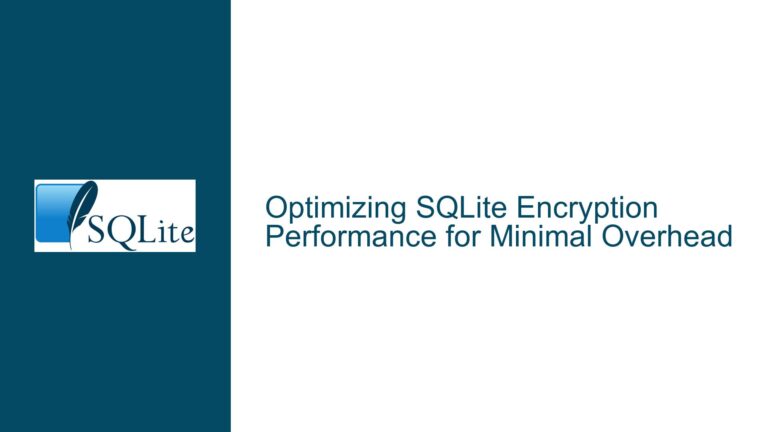WAL Checkpoint Blocking and Multi-Threaded Connections in SQLite
WAL Checkpoint Mechanics and Threaded Execution Challenges
The Write-Ahead Logging (WAL) mode in SQLite introduces performance improvements by decoupling write operations from read operations. However, its checkpointing mechanism introduces specific challenges when integrating multi-threaded workflows. A common issue arises when developers attempt to execute checkpoints in a background thread while performing write operations in a main thread. Misconfigurations in connection handling, transaction lifetimes, or threading modes can lead to partial checkpoints, blocked operations, or concurrency conflicts. This guide dissects the relationship between WAL checkpoints, active database connections, and long-running readers/writers to provide actionable solutions.
Checkpoint Blocking Scenarios and Thread-Safety Misconfigurations
1. Long-Running Readers and Unreset Statements
SQLite checkpoints require exclusive access to specific ranges of the WAL file to commit changes to the main database. When a read transaction remains open—even if no active SQL operations are executing—it retains a snapshot of the database. This snapshot forces the checkpointer to leave uncommitted WAL frames beyond the snapshot’s starting point. A common oversight occurs when developers reuse prepared statements without explicitly resetting them. If sqlite3_step() returns SQLITE_ROW (indicating a row is available) but the statement is not reset via sqlite3_reset(), the associated transaction remains active. This keeps the reader’s snapshot alive, blocking full checkpoints.
2. Single-Threaded Mode vs. Multi-Threaded Connection Handling
SQLite’s threading modes govern whether connections can be shared across threads. In single-thread mode, the library assumes no thread safety, prohibiting concurrent access to the same connection or database handle across threads. Developers often misinterpret this as a process-level restriction, but it specifically applies to threads. Attempting to checkpoint via a background thread while writing in the main thread without separate connections violates this constraint, causing undefined behavior or crashes. Even in multi-thread mode, connections themselves are not thread-safe; each thread must use its own connection.
3. Autocheckpoint Interference and Manual Checkpoint Coordination
SQLite’s autocheckpoint feature automatically triggers checkpoints after a certain number of WAL frames accumulate. Disabling autocheckpoint (via sqlite3_wal_autocheckpoint(db, 0)) allows manual checkpoint control but introduces risks. If manual checkpoints are executed on the same connection handling write transactions, the main thread’s write operations may block the checkpointer, or vice versa. This is exacerbated when transactions are not promptly finalized, leading to checkpoint starvation.
Resolving Checkpoint Blocking and Threading Conflicts
1. Connection Isolation for Multi-Threaded Checkpointing
To perform checkpoints in a background thread while writing in the main thread:
- Use Separate Connections: Create a dedicated connection for checkpointing in the background thread. This connection must not execute write operations or hold open transactions.
- Configure Threading Mode Correctly: Ensure SQLite is compiled with a threading mode (e.g., serialized mode) that allows concurrent access from multiple threads. Avoid single-thread mode unless all database interactions occur in one thread.
- Open Connections in Target Threads: SQLite connections are bound to the thread that opens them. Open the checkpointing connection in the background thread and the writer connection in the main thread.
Example Workflow:
// Main thread (writer)
sqlite3* writerDb;
sqlite3_open("database.db", &writerDb);
// Background thread (checkpointer)
void* checkpointThread(void* arg) {
sqlite3* checkpointDb;
sqlite3_open("database.db", &checkpointDb);
while (1) {
sqlite3_wal_checkpoint_v2(checkpointDb, NULL, SQLITE_CHECKPOINT_PASSIVE, NULL, NULL);
sleep(10); // Periodic checkpoints
}
}
2. Managing Prepared Statements and Snapshots
To prevent long-running readers from blocking checkpoints:
- Reset Statements Immediately After Use: Call
sqlite3_reset()on prepared statements as soon assqlite3_step()returnsSQLITE_DONEor when row processing is complete. This ends the statement’s transaction and releases its snapshot. - Avoid Reusing Statements Without Reset: Reusing a prepared statement without resetting it leaves its transaction open. Explicitly reset the statement before reuse.
- Use Short-Lived Transactions: Wrap write operations in explicit transactions with
BEGIN IMMEDIATEandCOMMITto minimize the window during which snapshots are held.
Anti-Pattern:
sqlite3_stmt* stmt;
sqlite3_prepare_v2(db, "SELECT * FROM table", -1, &stmt, NULL);
while (sqlite3_step(stmt) == SQLITE_ROW) {
// Process row
}
// Forgetting to reset the statement here keeps the transaction open
Corrected Approach:
while (sqlite3_step(stmt) == SQLITE_ROW) {
// Process row
}
sqlite3_reset(stmt); // Release snapshot
3. Checkpoint Mode Selection and Retry Logic
SQLite supports multiple checkpoint modes with varying levels of aggressiveness:
- PASSIVE Checkpoints: Do not block writers but may leave uncheckpointed WAL frames if readers are active.
- RESTART or TRUNCATE Checkpoints: Attempt to checkpoint the entire WAL file, blocking new writers until the checkpoint completes.
For non-blocking checkpoints:
- Use
SQLITE_CHECKPOINT_PASSIVEin the background thread. - Monitor the checkpoint result codes (
SQLITE_BUSY,SQLITE_LOCKED) and implement retry logic.
Example with Retry:
int rc;
do {
rc = sqlite3_wal_checkpoint_v2(checkpointDb, NULL, SQLITE_CHECKPOINT_PASSIVE, NULL, NULL);
if (rc == SQLITE_BUSY) {
usleep(100000); // 100ms delay
}
} while (rc == SQLITE_BUSY);
4. Thread Synchronization and Database Lock Management
- Busy Handlers and Timeouts: Set a busy handler to manage contention between threads. This allows the checkpointer to wait for locks instead of failing immediately.
sqlite3_busy_timeout(checkpointDb, 5000); // Wait up to 5 seconds for locks
- Avoid Cross-Thread Connection Sharing: Never share a connection handle across threads. Each thread must manage its own connection lifecycle.
5. Diagnosing Checkpoint Incompleteness
When checkpoints fail to fully commit WAL frames:
- Query
PRAGMA wal_checkpoint(TRUNCATE);to force a full checkpoint and inspect the output. - Use
sqlite3_wal_checkpoint_v2()withSQLITE_CHECKPOINT_RESTARTto identify whether active readers are the root cause. - Monitor the
sqlite3_status(SQLITE_STATUS_WAL_CHECKPOINT, ...)interface to track checkpoint attempts and outcomes.
By addressing connection isolation, statement lifecycle management, and checkpoint mode selection, developers can eliminate checkpoint blocking and ensure efficient WAL-based workflows. The interplay between SQLite’s threading model and transaction semantics requires meticulous attention to connection handling and snapshot retention to avoid subtle performance degradation or data inconsistency.






